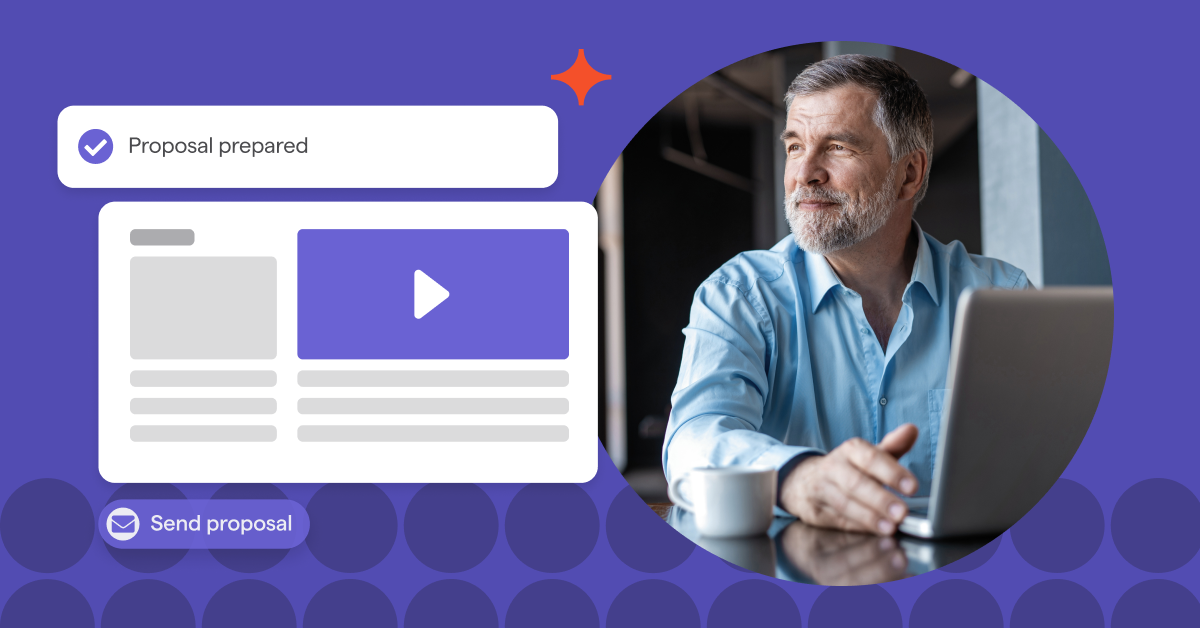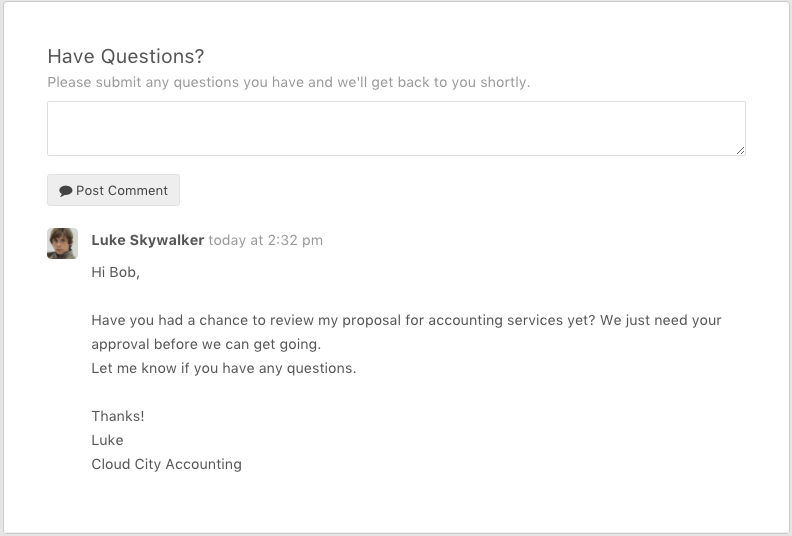How to write a business proposal that wins you more clients [with examples]

A business proposal is one of the most important documents you’ll create in your firm. Done right, it enables you to showcase your services, impress potential clients, and win more business. But when a proposal isn’t crafted properly, it’ll fail to make an impression and send potential customers elsewhere.
Needless to say, being thoughtful, thorough, and creative with your proposals is a must.
And if you need help doing that, this post has you covered. We’ll discuss:
What a business proposal is
The ideal business proposal format
How to get clients to accept a proposal
Let’s get started!
What is a business proposal?
The ideal business proposal format
Introduction or overview

Scope and services
Next, you need a section that describes the services you’ll provide to the client. For example, accountants can use this section to list the actions they’ll take to serve the clients. This can include things like:
Bookkeeping services
Running payroll
Tax planning
Tax filing
“A good proposal needs to have a really detailed scope of what the work is going to be,” says Joshua Lance, Head of Accounting at Ignition. He adds that being general or unclear with the scope can lead to inaccurate assumptions or mismatched expectations.
For example, you and the client may define the term “accounting services” differently. In your firm, “accounting services” may mean simply doing bookkeeping, but your client may expect the service to include tax preparation.
Aside from keeping you and your client on the same page, being clear with your service scope and description helps to better communicate your value, says Michelle Timperley, Account Manager at Ignition.
“If you enhance your description and tell your clients what you are doing, it adds more value to the service that you're delivering.”
She continues, “At the end of the day, the clients have no idea what a bookkeeper does. They have no idea what an accountant does. All they care about is the end result. If you just put ‘accounting services’ and a fee, clients won’t really know what those services entail.”
Here’s a great example of a clearly-worded scope of services from Ignition’s proposal template library. In the document below, the provider shares a detailed description of each of their services. Instead of just saying "Prepare a tax return," the document has a bullet list of all the steps and deliverables included in the service.

Follow the same format in your proposals so you can clearly communicate your offerings.
“We have to be very specific about what's in the scope and what's out of the scope, so it's clear what clients are actually buying and we're all on the same page,” says Joshua.
He says that the scope should also outline the responsibilities of both parties. This could mean:
You (the service provider) are expected to close the client’s books after 15 days
The client is expected to send their financial documents in a timely manner
Ironing out these expectations will help you avoid scope creep and ensure a smoother client engagement. Having clear expectations also prevents disputes from escalating.
According to Joshua, “If there's ever a disagreement down the line, we can always go back to that proposal and say, ‘Okay, well, what do we agree upon? What's in there?’. Having the right scope and expectations sets the stage for mutual agreement between the parties.”
Timeline
Payments
No business proposal is complete without a section on payments. This part should detail the fees you’ll charge and the schedule for when clients must remit the payments.
Similar to the Scope section, the Payments part of the proposal must be crystal clear to avoid misunderstandings.
As Joshua explains, “You need to be clear on pricing. If you're doing fixed fees, say what that fixed fee is. If you're doing hourly rates, put the hourly rate and give an expectation of how many hours you think it's going to be, so that person who's buying it knows what they're getting and there are no surprises later on.”
He continues, “I've seen too many accounting firms just say, ‘Oh, it's between $150 and $300 an hour,’ but they don't give any parameters around that. And then your client sees massive bills and they’ll think, ‘Okay, I didn't expect it to be that much.’”
These issues can be prevented by crafting a Payment section that’s straightforward and unambiguous. Aim to put a fixed dollar amount or at least a close estimate whenever possible.
Check out the business proposal sample below.

How to get clients to accept a proposal
Make sure your business proposal looks professional and on-brand
One key tip for creating a proposal that stands out is ensuring that it looks polished and it accurately reflects your brand.
“This is your way of setting yourself apart from other firms that the client may be talking to,” Joshua explains.
He adds, “It can't just look like a Word document because that doesn't represent you at all. It doesn't show who you are. So, if you’re a fun and tech-forward type of firm, your proposal and the things in it should reflect that.”
In addition, keeping your proposal on-brand creates a more seamless client experience. If they see that your proposal is consistent with your website, voice, and personality, they’ll have a better brand perception overall.
Regularly update your proposal
Michelle emphasizes the importance of keeping your proposal and accompanying brochure up to date. This includes using recent testimonials and keeping your team page current.
It’s also essential to regularly update your proposal’s terms and conditions. As Michelle points out, "Tax laws are constantly changing. Accountants need to be up to date with those changes and they need to make sure that they're updating their templates accordingly.”
Use video in your client proposal
Another great way to stand is to incorporate videos into your proposal. This will make it more dynamic and personal, ultimately increasing the likelihood of clients saying “Yes” to your proposal.
“Videos are amazing and underutilized in so many ways,” says Michelle. “When I started using videos in mine, my acceptance rate went from two days down to two hours.”
Joshua agrees. “Video comes across as more personal because they’re seeing you talking to them and explaining things,” he says. “It makes it feel more human,” particularly compared to traditional text-only client proposals.
As for what content to include, Michelle says you can use video to explain the proposal, outline the terms and conditions, and give instructions on how to accept it.
Ignition makes it simple to add videos to your proposal. Our software supports YouTube, Vimeo, and Loom, and there's no limit to the size and length of your videos.

Add a personalized note
Consider adding a personalized message to your proposal. You can use this as an opportunity to thank and reassure potential clients, so they feel at ease with reviewing and agreeing to your proposal.
Michelle also recommends adding links to these notes. For instance, if you have questionnaires or forms that need to be filled out, you can link to those materials so clients can easily access them.
Follow up with the potential client
Following up may feel like an awkward task, but it’s critical in the business proposal process. Research by Woodpecker found that users who follow up on their messages get an average reply rate of 13% compared to 9% for those who don't follow up.
If you’re uncomfortable with following up with prospects, you can make this step easier by using the right business proposal software.
Ignition, for example, enables you to send automated proposal reminders. Simply indicate how many days to wait before following up, and the software will send reminder messages automatically. You can also specify how many reminders to send.

Plus, Ignition lets you send reminders in bulk, for situations where you’re handling multiple proposals at once.
As for what to say in your follow-up message, it’s best to keep it short and sweet. Gently remind clients about the pending proposal and let them know that you’re there to answer any questions.
Check out the follow-up template below:

Remove friction from the “acceptance” process
So, you’ve sent a killer business proposal and the client is eager to move forward. What’s next?
The next logical step is for the client to inform you that they’re ready to move forward. They’ll sign an agreement and the service provider collects the initial payment.
Traditionally, this process takes some time because it requires clients to email you back, sign documents, and send over their payment information. This results in unnecessary back and forth between both parties.
Fortunately, solutions like Ignition streamline the acceptance process by allowing clients to agree to your proposal and remit their initial payments from within the same platform. They can enter their payment details through an online portal, without having to navigate away from the business proposals. From there, clients can sign the proposal and quickly get the ball rolling with the engagement.
Bringing it all together
Your business proposal can make or break a potential client relationship, which is why it’s critical that you put a lot of thought and effort into every proposal you send.
Need help doing just that? Ignition makes it easy to engage prospects and improve client engagements. Our built-in proposal tools streamline the process for both you and your clients, so you can get engagements up and running efficiently.
Get started for free or see Ignition in action by watching a demo.

